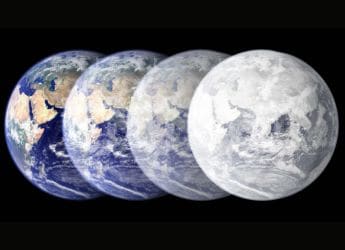- Home
- Science
- Science News
- ‘Starstruck’: NASA Shares Image of ‘Rediscovered’ Globular Star Cluster 35,000 Light Years Away From Earth
‘Starstruck’: NASA Shares Image of ‘Rediscovered’ Globular Star Cluster 35,000 Light Years Away From Earth
NASA said the cluster of stars has been discovered and rediscovered throughout time and is known by many names.

Photo Credit: ESA/ Hubble & NASA, E. Noyola
NASA said the globular cluster is in constellation Scorpio located 35,000 light-years from Earth
Space is a repository of planets, galaxies, and umpteen stars. And agencies such as NASA and European Space Agency (ESA) have, from time to time, brought to us some breathtaking visuals, in a way acting as a bridge between humans and the universe. On Saturday, NASA shared a fascinating view of what is referred to as a snow-globe-shaped island comprising several hundred thousand stars. Held together by gravity, these stars make up a globular cluster, which was photographed by NASA's Hubble Space Telescope. In an Instagram post, NASA wrote that the globular cluster was in the constellation, Scorpio, located 35,000 light-years away from the Earth.
“Globular clusters are spherical groups of stars held together by gravity. They often contain some of the oldest stars in their galaxies,” added the space agency. Quite fascinating to hear, though, that this cluster has been discovered and rediscovered throughout time and is known by many names.
NASA said that it was first discovered by James Dunlop in 1826, only to be rediscovered eight years later in 1834, and then over a century later again in 1959.
“Nowadays, this cluster is reliably recognised in widely available catalogues,” it said.
Furthermore, in a note on its website, NASA said that the very bright star at the top of the image was HD 159073, only around 4,000 light-years from the Earth. That also made it a much nearer neighbour than NGC 6380, said the space agency.
NASA further goes on to mention the discovery and subsequent rediscoveries of the NGC 6380 cluster. NASA states that the cluster was discovered by James Dunlop in 1826. Then, in 1834, “it was independently rediscovered by John Herschel”. Again, in 1959, “the cluster was re-rediscovered” by Paris Pismis.
The cluster was photographed by Hubble's Wide Field Camera 3 that has a wide field of view, which means that it can capture a relatively large area of the sky. And, with that, NASA also announced that all the instruments on its Hubble Space Telescope were now operational again and science data was being collected once again to expand the human understanding of the universe.
The orbiting observatory had gone dark in mid-June, with all astronomical viewing halted, but it has been fixed now.
Get your daily dose of tech news, reviews, and insights, in under 80 characters on Gadgets 360 Turbo. Connect with fellow tech lovers on our Forum. Follow us on X, Facebook, WhatsApp, Threads and Google News for instant updates. Catch all the action on our YouTube channel.
Related Stories
- Samsung Galaxy Unpacked 2025
- ChatGPT
- Redmi Note 14 Pro+
- iPhone 16
- Apple Vision Pro
- Oneplus 12
- OnePlus Nord CE 3 Lite 5G
- iPhone 13
- Xiaomi 14 Pro
- Oppo Find N3
- Tecno Spark Go (2023)
- Realme V30
- Best Phones Under 25000
- Samsung Galaxy S24 Series
- Cryptocurrency
- iQoo 12
- Samsung Galaxy S24 Ultra
- Giottus
- Samsung Galaxy Z Flip 5
- Apple 'Scary Fast'
- Housefull 5
- GoPro Hero 12 Black Review
- Invincible Season 2
- JioGlass
- HD Ready TV
- Laptop Under 50000
- Smartwatch Under 10000
- Latest Mobile Phones
- Compare Phones
- Huawei Nova 15
- Huawei Nova 15 Pro
- Huawei Nova 15 Ultra
- OnePlus 15R
- Realme Narzo 90x 5G
- Realme Narzo 90 5G
- Vivo S50 Pro Mini
- Vivo S50
- Asus ProArt P16
- MacBook Pro 14-inch (M5, 2025)
- Huawei MatePad 11.5 (2026)
- OnePlus Pad Go 2 (5G)
- Huawei Watch 10th Anniversary Edition
- OnePlus Watch Lite
- Acerpure Nitro Z Series 100-inch QLED TV
- Samsung 43 Inch LED Ultra HD (4K) Smart TV (UA43UE81AFULXL)
- Asus ROG Ally
- Nintendo Switch Lite
- Haier 1.6 Ton 5 Star Inverter Split AC (HSU19G-MZAID5BN-INV)
- Haier 1.6 Ton 5 Star Inverter Split AC (HSU19G-MZAIM5BN-INV)

















